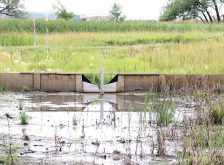Prairie farmers have become very successful at growing very good yielding, high quality crops. Success is due in large part to many years of excellent agronomic research including advances in crop breeding, sustainable crop rotations, improved soil management, development of direct seeding technology, development of fertilizer and nutrient management practices and improved management to control weeds, insects and diseases. Advances in all these disciplines have collectively contributed to improved crop production.
Soil and crop scientists continue to work together with producer groups and industry organizations to focus on ways to improve soil management and increase crop production potential. But, could agronomic research in Western Canada be more effective and efficient in the future? You bet.
Read Also

Claas brings 1000 Series SP forage harvesters to Canada
In mid-August, Claas unveiled its new line of Jaguar forage harvesters at an event in Visalia, California, deep in the heart of that state’s dairy region.
The Agricultural Institute of Canada has recently released a document titled: Leading in Sustainability: An Agricultural Research, Innovation and Development Policy for the Future. (Find it online at aic.ca) It is definitely worth a read.
Should farmers be concerned about how agronomic research will get done in Western Canada? Farmers need agronomy research to keep pace with other countries and regions of the world. If emphasis on research in Canada lags behind other countries, agricultural production will lag behind as well, putting farmers and the Canadian agricultural economy at a disadvantage. Improved ag production and crop quality will continue to depend on how agronomic research is managed and conducted.
Some important research issues include:
- How are research priorities determined?
- How well is research planned, co-ordinated and conducted across the Prairies?
- How are research projects funded?
- How is research information disseminated to farmers?
1. Research priorities
Setting short- and long-term research priorities is relatively easy. Most researchers are very familiar with the gaps in research knowledge in their areas of speciality. Leading edge farmers are aware of the issues that need attention in the regions they farm. Collectively, farmers, producer organizations, researchers and industry agronomists can develop good research priority plans for the various crops and agro-ecological regions of Western Canada, which can be updated and refined on an on-going basis.
2. Planning, co-ordinating and conducting research
Co-ordinating and conducting research is probably the greatest challenge. There are many agencies conducting agronomic research across the Prairies. These include: Agriculture and Agri-Food Canada (AAFC) with six research centres, the Universities of Alberta, Saskatchewan and Manitoba, the three prairie provincial government departments of agriculture, and a number of applied research associations and private companies.
There are plenty of groups conducting research.
Some researchers make great efforts to co-ordinate research with other agencies. But, at times, agencies end up competing with each other. In some cases they simply don’t want to work with other groups. There are times when different agencies are conducting very similar research projects but don’t or won’t communicate, resulting in duplication. This is not good for our industry.
Fortunately, most researchers are more than willing to conduct co-operative research. But some aren’t. There are times when some researchers or agencies want to be the heroes, overshadowing the work of others. To collectively make good research advances, there is no room for professional jealousy!
There is room for improving research project planning and co-ordination to make the best use of people, equipment, resources and funding.
Ideally, various research agencies should combine into one well-co-ordinated research group to conduct agronomic research across the Prairies. But there is little chance of that every happening.
Across the Prairies we need about 16 agronomy research centres, placed strategically in uniquely different agro-ecological regions. Each centre would need to be staffed with soil and crop researchers.
Crop breeding research could be focused at a selected research centres. All research centres would be involved in conducting annual variety trials at multiple sites within their region. Co-ordinated varieties trials conducted using the same methodology at all locations would ensure more consistent results. Presently, each province looks after variety trials and uses different standard varieties. This makes comparison of variety information from different provinces difficult. Having one group co-ordinating this and other types of agronomic research would give Prairie farmers higher quality information.
Co-ordinated research would have many benefits. For example, fertilizer research could be conducted at all centres to constantly update fertilizer response curves for all major crops, for each uniquely different agro-ecological area of the prairies. Specialty fertilizers could be evaluated at selected centres to determine when and where they might be effective. Presently, fertilizer recommendations for some crops and regions are up to 40 years old and sadly in need of updating. But this is not exciting new research so it doesn’t get done. However, it is essential research to keep fertilizer recommendations current for new crop varieties and in line with all other agronomic advances.
3. Research funding
Most researchers must depend on research project grants from funding agencies to conduct their research. Funding is needed to pay for research staff, laboratory and field equipment, travel, and research supplies. Research staff must be very well trained and they need the best, most up-to-date lab and field equipment to be successful and provide the best information to farmers. This is no different than farmers needing well-trained staff and up-to-date field equipment.
Most researchers will spend four to six weeks or more of their valuable time each year developing and writing research proposals for funding agencies. Researchers feel they must go on bended knee looking for research funding. Their research applications may only be successful 20 per cent of the time. This is an inefficient process and a not a good use of a researcher’s value time.
As mentioned, agronomy research would be more efficient if conducted by a well-co-ordinated group. That research group must be well funded by the federal government, provincial governments, producer organizations and industry. This would reduce the time wasted chasing research funding.
Research funding agencies using application processes should consider having one Prairie-wide research funding consortium to streamline the funding process. This would reduce the potential for duplication of research projects and help to ensure co-ordinated research across the prairies. This would allow researchers to focus on their research, and not on competing with each other for research dollars. This could result in much more effective, efficient and well-co-ordinated agronomy research across the prairies.
In my opinion there is huge potential to improve agronomic research planning, co-ordination and funding in the future.
4. Extension of research information
Getting the research results into the hands for farmers is also a great challenge that I will focus on in a future column.
















